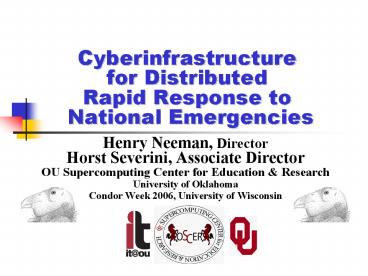Cyberinfrastructure for Distributed Rapid Response to National Emergencies - PowerPoint PPT Presentation
Title:
Cyberinfrastructure for Distributed Rapid Response to National Emergencies
Description:
Condor Week 2006, University of Wisconsin. Disasters ... 14 TB disk (SAN IBRIX) Infiniband & Gigabit Ethernet. Red Hat Linux Enterprise ... – PowerPoint PPT presentation
Number of Views:37
Avg rating:3.0/5.0
Title: Cyberinfrastructure for Distributed Rapid Response to National Emergencies
1
Cyberinfrastructurefor DistributedRapid
Response to National Emergencies
- Henry Neeman, Director
- Horst Severini, Associate Director
- OU Supercomputing Center for Education Research
- University of Oklahoma
- Condor Week 2006, University of Wisconsin
2
Disasters
3
The Problem and the Solution
- The Problem Problems will happen.
- The problem is that we dont know the problem.
- The solution is to be able to respond to unknown
problems with unknown solutions. - Unknown problems that have unknown solutions may
require lots of resources. - But, we dont want to buy resources just for the
unknown solutions to the unknown problems which
might not even happen. - The Solution Be able to use existing resources
for emergencies.
4
Who Knew?
http//www.ncdc.noaa.gov/oa/climate/research/2005/
katrina.html
5
National Emergencies
- Natural
- Severe storms (e.g., hurricanes, tornadoes,
floods) - Wildfires
- Tsunamis
- Earthquakes
- Plagues (e.g., bird flu)
- Intentional
- Dirty bombs
- Bioweapons (e.g., anthrax in the mail)
- Poisoning the water supply
- (See Bruce Willis/Harrison Ford movies for more
ideas.)
6
How to Handle a Disaster?
- Prediction
- Forecast phenomenon's behavior, path, etc.
- Amelioration
- Genetic analysis of biological agent (find cure)
- Forecasting of contaminant spread (evacuate whom?)
7
OSCER's Project
- NSF Small Grant for Exploratory Research (SGER)
- Configure machines for rapid switch to Condor
- Maintain resources in state of readiness
- Train operational personnel maintain, react,
analyze - Fire drills
- Generate, conduct and analyze scenarios of
possible incidents
8
_at_ OU Available for Emergencies
- 512 node Xeon64 cluster (6.5 TFLOPs peak)
- 135 node Xeon32 cluster (1.08 TFLOPs peak)
- 32 node Itanium2 cluster (256 GFLOPs peak)
- Desktop Condor pool growing to 750 Pentium4 PCs
(4.5 TFLOPs peak) - TOTAL 12.4 TFLOPs
9
Dell Xeon64 Cluster
- 1,024 Pentium4 Xeon64 CPUs
- 2,180 GB RAM
- 14 TB disk (SANIBRIX)
- Infiniband Gigabit Ethernet
- Red Hat Linux Enterprise
- Peak speed 6.5 TFLOPs
- Usual scheduler LSF
- Emergency Scheduler Condor
topdawg.oscer.ou.edu
DEBUTED AT 54 WORLDWIDE, 9 AMONG US UNIVS, 4
EXCLUDING BIG 3 NSF CENTERS
www.top500.org
10
Aspen Systems Xeon32 Cluster
- 270 Xeon32 CPUs
- 270 GB RAM
- 10 TB disk
- Myrinet2000
- Red Hat Linux Enterprise
- Peak speed 1.08 TFLOPs
- Scheduler Condor
- Will be owned by High Energy Physics group
- DEBUTED at 197 on the Top500 list in Nov 2002
www.top500.org
boomer.oscer.ou.edu
11
Aspen Systems Itanium2 Cluster
- 64 Itanium2 1.0 GHz CPUs
- 128 GB RAM
- 5.7 TB disk
- Infiniband Gigabit Ethernet
- Red Hat Linux Enterprise 3
- Peak speed 256 GFLOPs
- Usual scheduler LSF
- Emergency scheduler Condor
schooner.oscer.ou.edu
12
Dell Desktop Condor Pool
- OU IT is deploying a large Condor pool (750
desktop PCs) over the course of the 2006 - 3 GHz Pentium4 (32 bit), 1 GB RAM, 100 Mbps
network connection. - When deployed, itll provide 4.5
TFLOPs (peak) of additional computing power
more than is currently available at most
supercomputing centers. - Currently, the pool is 136 PCs in
a few of the student labs.
13
National Lambda Rail _at_ OU
- Oklahoma has just gotten onto NLR the pieces are
all in place but were still configuring.
14
MPI Capability
- Many kinds of national emergencies weather
forecasting, floods, contaminant distribution,
etc. use fluid flow and related methods, which
are tightly coupled and therefore require MPI. - Condor provides the MPI universe.
- Most of the available resources 7.9 TFLOPs
out of 12.8 are clusters, ranging from
¼ TFLOP to 6.5 TFLOPs. - So, providing MPI capability is straightforward.
15
Fire Drills
- Switchover from production to emergency Condor
- Shut down all user jobs on the production
scheduler. - Shut down the production scheduler (if not
Condor e.g., LSF). - Start Condor (if necessary).
- Condor jobs for national emergency discover these
resources and start themselves. - We've done this several times at OU.
- Only during scheduled downtimes!
- Switchover times range from 9 minutes down to 2.5
min. - Pretty much we have this down to a science.
16
Thanks for your attention!Questions?































